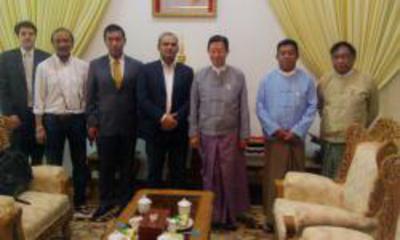|
|
Myanmar Invites Nonviolent Peaceforce to Support Peace Processes
un article par Nonviolent Peaceforce
The Government of Myanmar, also known as Burma, has formally invited Nonviolent Peaceforce (NP) to implement an unarmed civilian peacekeeping progamme there which will support the ambitious peace initiatives in moving forward.

Atif Hameed, NP Director of Programs, fourth from left and other NP representative with Minister of the President’s Office of Myanmar and other Government Representatives, November 2012, Yangon, Myanmar. “The peace processes in Myanmar have reached a critical stage, a stage where both local and national-level governments as well as a budding local civil society involved with peace initiatives need the international community’s support,” said Atif Hameed, NP’s Director of Programmes (pictured fourth from right in the photo).
The government has made significant progress towards ending the decades-long intra-state armed conflicts with numerous ethnic-minority armed groups. As a first step, until the time of writing, they have signed at least 11 ceasefires since September 2011.
And in November 2012 they officially launched the Myanmar Peace Center (MPC), which is to serve essentially as the primary institution involved in the numerous peace processes.
Given its expertise in civilian protection and in particular its work in the Philippines where it is an official member of the ceasefire mechanism, NP was requested to “promptly begin programs” supporting the initiatives of Myanmar’s newly formed Myanmar Peace Center..
This may include, for example, support in providing technical advice in further refining and setting up ceasefire monitoring mechanisms where parties to a conflict agree to certain rules and establish coordination and communications mechanisms with the aim of avoiding misunderstandings that could eventually lead to violence. Such an atmosphere on the ground can stifle higher-level negotiations.
NP was also requested to support “local organizations build their own capacity to be effective and informed actors in the various peace processes.”
The invitation comes in the wake of two exploratory visits undertaken by NP’s Project Development Team in July and November 2012 where they met with a wide array of stakeholders including Minister Thu Aung Minh, Minister of the President’s Office of Myanmar (pictured third from right in the photo) who is in charge of the peace processes.
NP is currently in the process of signing a Memorandum of Understanding with the Myanmar Peace Center and key local civil society organisations to operationalise its support to the peace processes in Myanmar.
|








|
DISCUSSION
Question(s) liée(s) à cet article:
Can peace be guaranteed by nonviolent means?,
* * * * *
Commentaire le plus récent:
We have the advantage of an independent evaluation of the Nonviolent Peaceforce initiative in the Philippines conducted by Swisspeace. The evaluation is very favorable, although in the end, as one reads through it, gets the impression that such initiatives can help but cannot bring peace by themselves.
Here is the executive summary:
Nonviolent Peaceforce in the Philippines can look back at more than two years of unique, relevant contributions and constructive engagement in one of the most difficult, political and volatile, contexts to work in: Being the only international non-governmental organization working with and living in close proximity to the most conflict-affected population in Mindanao, NP in the Philippines was able to support and enhance local structures of cease-fire monitoring, early warning, cross-community dialogues, human rights protection, to offer civilian protection and help to reduce the high levels of community violence.
The accepted offer to NP in the Philippines in late 2009 by the conflict parties GRP and the MILF to join the International Monitoring Team1 (IMT) and its Civilian Protection Component is a direct expression and result of its successful contributions to non-violence and violence reduction of the last two years.
To keep up the important work of NP’s project in the Philippines in the years to come, it is essential to ensure that the activities and objectives of NPP are based on a strategically and conceptually sound footing. This seems even more important given that NPP is going through a remarkable consolidation and expansion phase at the time of report-writing.
The re-focus on its key mandate, strengths and strategic advantages in Mindanao gives NP the opportunity to further enhance its unique work in the area of nonviolence, peacekeeping and peacebuilding.

|
|









